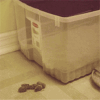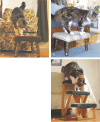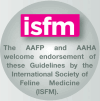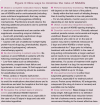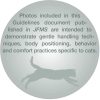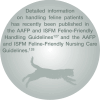2015 AAHA/AAFP pain management guidelines for dogs and cats - PubMed (original) (raw)
Practice Guideline
2015 AAHA/AAFP pain management guidelines for dogs and cats
Mark E Epstein et al. J Feline Med Surg. 2015 Mar.
Abstract
Rationale: The robust advances in pain management for companion animals underlie the decision of the American Animal Hospital Association (AAHA) and American Association of Feline Practitioners (AAFP) to expand on the information provided in the 2007 AAHA/AAFP Pain Management Guidelines. The 2015 Guidelines summarize and offer a discriminating review of much of this new knowledge.
Relevance: Pain management is central to veterinary practice, alleviating pain, improving patient outcomes, and enhancing both quality of life and the veterinarian-client-patient relationship. These Guidelines support veterinarians in incorporating pain management into practice, improving patient care.
Approaches: The management of pain requires a continuum of care that includes anticipation, early intervention, and evaluation of response on an individual patient basis. A team-oriented approach, including the owner, is essential for maximizing the recognition, prevention and treatment of pain in animals.
Evidence base: The Guidelines include both pharmacologic and non-pharmacologic modalities to manage pain; they are evidence-based insofar as possible and otherwise represent a consensus of expert opinion. Behavioral changes are currently the principal indicator of pain and its course of improvement or progression, and the basis for recently validated pain scores. Post-surgical pain is eminently predictable but a strong body of evidence exists supporting strategies to mitigate adaptive as well as maladaptive forms. Chronic pain is dominated by degenerative joint disease (DJD), which is one of the most significant and under-diagnosed diseases of cats and dogs. DJD is ubiquitous, found in pets of all ages, and inevitably progresses over time; evidence-based strategies for management are established in dogs, and emerging in cats.
© ISFM and AAFP 2015.
Conflict of interest statement
Mark Epstein has previously consulted for Abbott, Elanco and Merial. Sheilah Robertson is a key opinion leader for Novartis Animal Health.
Figures
Image 1
(a,b) Signs of acute pain include squinting, and a hunched or tucked-up position instead of sleeping in a normal curled-up position (see Image 2). Images courtesy of Sheilah Robertson
Image 2
Cats normally sleep in a curled-up position, as seen in this patient, when provided with adequate analgesia. Courtesy of Sheilah Robertson
Image 3
Following assessment from a distance, palpation of the surgical site is performed to further assess acute pain. Courtesy of Sheilah Robertson
Image 4
Lack of normal behaviors, such as reduced grooming, is commonly seen in painful cats. Image iStock/jvoisey
Image 5
Cats may start to perform abnormal behaviors secondary to pain, such as defecating outside of the litter box, either because the cat cannot get downstairs to the box or it cannot jump into the box. Courtesy of Sheilah Robertson
Image 6
Note how comfortable cats usually are for acupuncture therapy. Courtesy of Sheilah Robertson
Image 7
Environmental management is needed in addition to medical management for cats with DJD. Providing a stool (a,b), ramp or step(s) (c) allows the cat to reach favored areas. Pet steps are commercially available or can be built; those pictured in (c) were built by Dr Robert Wright of The Cat Doctor in Portland ME, USA. Images courtesy of Deb Givin
Image 8
(a) Muscle wasting over affected legs is a common sign of DJD, as seen in this orange tabby, (b) Close-up of the front limbs of the cat, showing deformities secondary to DJD. Images courtesy of Ilona Rodan
Image 9
Since DJD is ubiquitous, can occur in cats of all ages, and can be difficult to detect, every effort should be made to incorporate gentle handling techniques for all cats. For example, gently pushing the front leg forward from behind the humerus, instead of pulling on the front foot, will help to prevent elbow pain. Courtesy of Ilona Rodan
Image 10
Instead of stretching and pulling hind legs back tightly, gently place one or more fingers between the hind feet and hold without stretching. This prevents exacerbation of lumbar, lumbosacral, knee and hip pain. Courtesy of Ilona Rodan
Image 11
(a) Note this cat’s uncomfortable stance while eating caused by DJD. (b) Raising the food onto a low shelf allows the cat to sit normally and eat comfortably. Images courtesy of Margie Scherk
Image 12
The gray and white cat in (a) is seen as gregarious and is choosing to climb to higher locations. Image (b) shows the same cat with DJD and the inability to jump. Provision of a step allows the cat in image (c) to perch in a favored place. Images courtesy of Sheilah Robertson
Similar articles
- 2015 AAHA/AAFP Pain Management Guidelines for Dogs and Cats.
Epstein M, Rodan I, Griffenhagen G, Kadrlik J, Petty M, Robertson S, Simpson W. Epstein M, et al. J Am Anim Hosp Assoc. 2015 Mar-Apr;51(2):67-84. doi: 10.5326/JAAHA-MS-7331. J Am Anim Hosp Assoc. 2015. PMID: 25764070 - AAHA/AAFP pain management guidelines for dogs & cats.
American Animal Hospital Association; American Association of Feline Practitioners; AAHA/AAFP Pain Management Guidelines Task Force Members; Hellyer P, Rodan I, Brunt J, Downing R, Hagedorn JE, Robertson SA. American Animal Hospital Association, et al. J Am Anim Hosp Assoc. 2007 Sep-Oct;43(5):235-48. doi: 10.5326/0430235. J Am Anim Hosp Assoc. 2007. PMID: 17823472 - AAHA/AAFP pain management guidelines for dogs and cats.
AAHA/AAFP Pain Management Guidelines Task Force Members; Hellyer P, Rodan I, Brunt J, Downing R, Hagedorn JE, Robertson SA. AAHA/AAFP Pain Management Guidelines Task Force Members, et al. J Feline Med Surg. 2007 Dec;9(6):466-80. doi: 10.1016/j.jfms.2007.09.001. Epub 2007 Nov 8. J Feline Med Surg. 2007. PMID: 17997339 Free PMC article. - AAFP-AAHA: feline life stage guidelines.
Hoyumpa Vogt A, Rodan I, Brown M, Brown S, Buffington CA, Larue Forman MJ, Neilson J, Sparkes A. Hoyumpa Vogt A, et al. J Feline Med Surg. 2010 Jan;12(1):43-54. doi: 10.1016/j.jfms.2009.12.006. J Feline Med Surg. 2010. PMID: 20123486 Free PMC article. Review. - Analgesia for small animal thoracic surgery.
Pavlidou K, Papazoglou L, Savvas I, Kazakos G. Pavlidou K, et al. Compend Contin Educ Vet. 2009 Sep;31(9):432-6; quiz 436. Compend Contin Educ Vet. 2009. PMID: 20180209 Review.
Cited by
- A combined treatment for self-traumatic chronic skin lesions associated with post-surgical neuropathic pain in a domestic cat: a pharmacological and cold atmospheric plasma approach.
de Moura CEB, Francelino LEC, da Silva GRV, Júnior CA, Façanha DAE, Nunes TL, de Paula VV. de Moura CEB, et al. Vet Res Commun. 2024 Oct;48(5):3263-3270. doi: 10.1007/s11259-024-10499-6. Epub 2024 Aug 12. Vet Res Commun. 2024. PMID: 39133400 - Inter-rater reliability in performing stifle goniometry in normal and cranial cruciate ligament disease affected dogs: a prospective randomized controlled study.
Volz F, Schmutterer JM, Vockrodt TS, Zablotski Y, Lauer SK. Volz F, et al. BMC Vet Res. 2024 Aug 1;20(1):339. doi: 10.1186/s12917-024-04206-5. BMC Vet Res. 2024. PMID: 39085899 Free PMC article. - Development and validation of a quality of life and treatment satisfaction measure in canine osteoarthritis.
Gildea E, Scales-Theobald E, Thompson J, Cook A, Forde K, Skingley G, Lawrie S, Williamson N, Panter C. Gildea E, et al. Front Vet Sci. 2024 May 3;11:1377019. doi: 10.3389/fvets.2024.1377019. eCollection 2024. Front Vet Sci. 2024. PMID: 38764853 Free PMC article. - Comparison of Two Surgical Techniques Based on the Semitendinosus Myocutaneous Flap in Cats.
Dermisiadou E, Panopoulos I, Psalla D, Georgiou S, Sideri A, Galatos A, Tsioli V. Dermisiadou E, et al. Vet Sci. 2023 Dec 20;11(1):6. doi: 10.3390/vetsci11010006. Vet Sci. 2023. PMID: 38275922 Free PMC article. - Comparison of the efficacy and perioperative pain between vessel sealing and suture ligation for median celiotomy in canine ovariohysterectomy.
Sunghan J, Manmoo S, Suriyasathaporn W, Suriyasathaporn W, Warrit K, Kusolphat P. Sunghan J, et al. Vet World. 2023 Feb;16(2):386-394. doi: 10.14202/vetworld.2023.386-394. Epub 2023 Feb 28. Vet World. 2023. PMID: 37042013 Free PMC article.
References
- American Animal Hospital Association; American Association of Feline Practitioners; AAHA/AAFP Pain Management Guidelines Task Force Members, Hellyer P, Rodan I, Brunt J, et al.. AAHA/AAFP pain management guidelines for dogs & cats. J Am Anim Hosp Assoc 2007; 43: 235–248. - PubMed
- Reid J, Scott M, Nolan A, et al.. Pain assessment in animals. In Pract 2013; 35: 51–56.
- Shanan A. A veterinarian’s role in helping pet owners with decision making. Vet Clin North Am Small Anim Pract 2011; 41: 635–646. - PubMed
Publication types
MeSH terms
Substances
LinkOut - more resources
Full Text Sources
Medical
Miscellaneous




